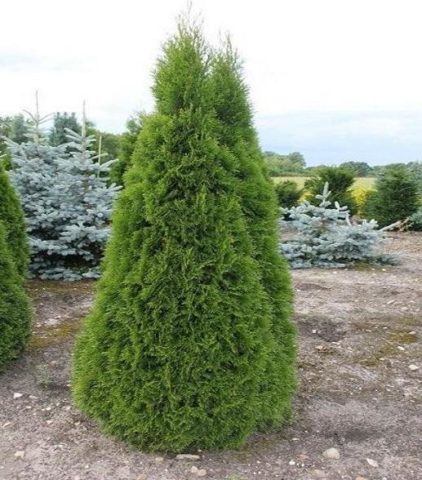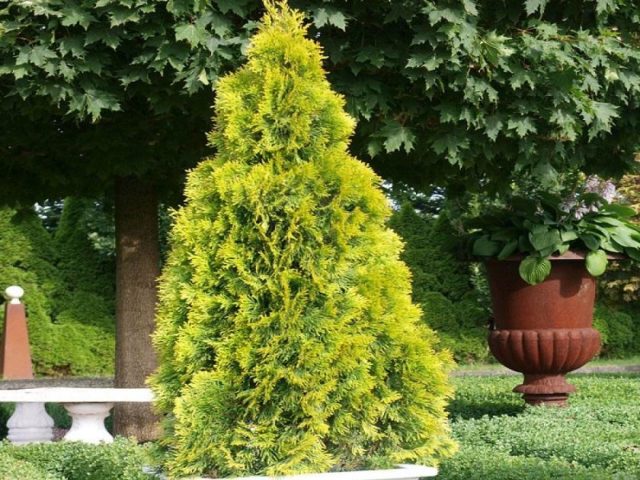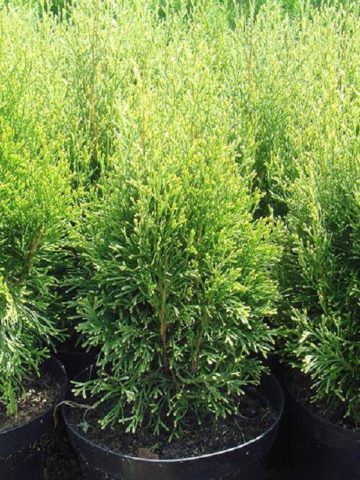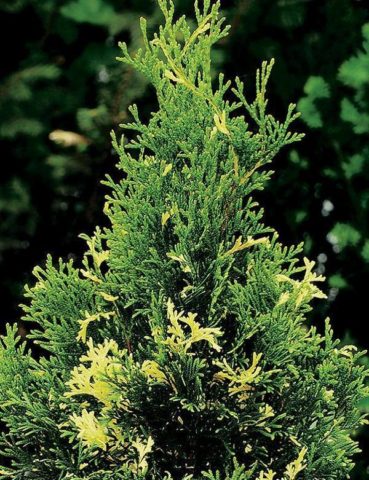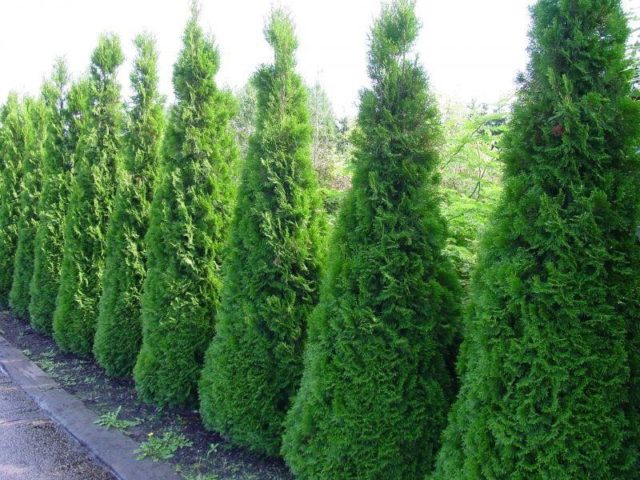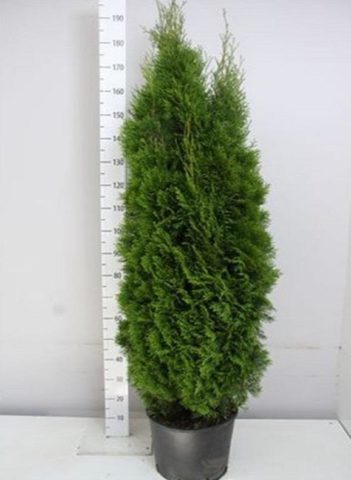Content
Thuja Smaragd belongs to the tall trees of the cypress family. The ornamental plant has the shape of a pyramid. A distinctive feature of the variety is the preservation of its green color even in winter.
An unpretentious plant makes the garden unique, cozy at any time of the year.
You should know the peculiarities of growing thuja, caring for it, methods of reproduction in order to avoid problems during planting and further cultivation.
Description of thuja Smaragd
According to the description and photo, the western thuja Smaragd has one of the best conical shapes.
The crown of the ephedra is narrow, dense, pyramidal. The variety was bred in Denmark. The plant grows quickly. His needles are scaly, bright green, thick. The branches are arranged vertically.
Cones are brown, rare. Their shape is oval, elongated, up to 1 cm long.
The average life span of a plant is 130 years. The tree grows quickly. Annual growth is 20 cm in height and about 5 cm in width.
Ephedra is widely used for hedges and in single plantings. Unlike the Kolumna variety, Smaragd grows more slowly and has brighter needles, and in an adult state it is 3 m shorter in height. The main difference is that Kolumna has a cylindrical crown.
Thuja is able to carry polluted air, saturating it with useful phytoncides, especially during flowering. The culture is frost-resistant, not demanding on the soil, unpretentious in care.
Sizes of an adult plant thuja Smaragd
With a sufficiently rapid growth, the height of an adult thuja Smaragd is 5 - 6 m. This should be remembered when determining the planting site, since after a few years a tree grows that can close the view. There are varieties of thuja Smaragd with a height of up to 3 m, which allows them to be successfully used for hedges. The crown width is 70 - 80 cm. The trees are planted at a distance of 50 cm from each other.
The growth rate of thuja depends on the variety and averages 25 cm per year.
Varieties and varieties of western thuja Smaragd
There are several popular varieties of thuja Smaragd, differing in the height of plants in adulthood, the rate of annual growth, and appearance:
- Sunny Smaragd - with a conical crown and golden-green needles, the maximum plant height is 3 m;
- Golden Smaragd - has a golden crown, short, densely spaced shoots, the growth of an ephedra in an adult state is 10 m;
- Smaragd Variegata - the crown of the tree is conical, narrow, bright green, the ends of the shoots are white;
- Smaragd Whitbont - one of the slowest growing varieties of thuja, which is ideal for creating hedges, crown 2 m high, pyramidal, green-cream;
- Spotty Smaragd - the tree has a magnificent appearance, a pyramidal crown, green needles with light specks;
- Spiral - thuja with a unique spiral shape of the crown, looks perfect in single plantings.
The use of thuja Smaragd in landscape design
Thuja Smaragd has clear and slender forms, therefore, most often it is used as a fence for paths in parks, squares, in an urban environment.
Tui look great singly and in groups. Even a single tree on a neatly trimmed lawn looks impressive.
Groups of five to seven plants, planted together, emphasize the geometry of the site, make it clearer, more organic.
Thuja Smaragd is appropriate near reservoirs, the entrance to the house, as well as the garden.
Thuja Smaragd hedge
As you can see in the photo, in landscape design, thuja Smaragd are most successfully used to create spectacular hedges.
Slender trees, densely planted in relation to each other, can replace any fence - stone, metal, brick. It's just that such a fence consists in the retention and absorption of dust and harmful substances emitted by transport, protection from wind and noise. Such a fence gives the site privacy and comfort. Caring for a hedge is simple - it is enough to cut it in time.
How can thuja Smaragd be propagated
There are several ways to reproduce thuja Smaragd. Among them:
- seminal - only fresh material is used for sowing, since germination is lost after a year, the characteristics of the variety may not be preserved after growing thuja from seeds;
- horizontal layering - does not guarantee the preservation of the crown shape;
- cuttings - the most commonly used method, which uses lateral branches with a heel that can root well.
Layers
Thuja Smaragd is a plant that can be propagated using layering, but this method does not give a guaranteed result of preserving the pyramidal shape of the crown.
For rooting, one of the lower branches of the thuja is bent to the ground and pinned into a groove prepared in advance. It is covered with soil, and the top of the shoot is set in a vertical position. Often, lopsided seedlings grow from rooted branches, the shape of which can gradually be corrected. It takes about a year for rooting, after which the seedling is separated from the mother plant and transferred to a permanent place.
Cuttings
All types of thuja are propagated using the vegetative method. Cuttings are harvested in early spring, when the plant has not yet been activated. Cut off mature branches 10 - 12 cm long and 1 cm thick.The cut is made at an angle of 45o... You can also not cut, but pluck the stalk with a piece of bark and wood. All branches are removed, except for the top, and the cut is treated with a root formation stimulator. Cuttings are planted in a soil mixture consisting of sand, humus and vermiculite in equal proportions. The soil is compacted, watered, the shoots are covered with a film to create a microclimate.
Once the cuttings begin to grow, it means that they are rooted, but not ready for transplanting, as the root system is small and fragile. Therefore, the seedlings should be grown and only after a year or two be planted in a permanent place.
Planting and caring for thuja Smaragd
Despite the unpretentiousness of the plant, planting and caring for the western thuja Samgard should take place according to certain rules:
- Choose a place according to the needs of the plant.
- Purchase a seedling without damage, with healthy needles and a root system.
- Find a soil that is well-drained, moisturized, and breathable.
- Regularly carry out fertilizing and watering.
- Carry out sanitary and periodic pruning.
- Conduct thuja pest and disease control.
- Protect young seedlings from burns.
- Prepare plants for winter.
Recommended timing
The optimal planting time for thuja Smaragd is spring.Experts advise doing this as early as possible so that the plant has enough time to adapt to new conditions and prepare for wintering. As soon as weather and climatic conditions permit, the seedling is placed in open ground.
In autumn, thuja Smaragd takes root worse. Sometimes she does not have enough time to root. To improve the habituation of seedlings, it is worth purchasing plants with a closed root system. If agricultural technology is violated, the tree starts to grow for a long time in spring, slowly develops.
Site selection and soil preparation
Thuja Smaragd turns yellow if planted incorrectly. It requires a sunny location with full light for at least four hours a day. Variegated varieties do not lose their color in the shade, but at the same time their growth is greatly slowed down.
When thuja is planted close to other trees and shrubs, its crown may bend, form one-sided. Even after removing vegetation or replanting a seedling, it is difficult to fix it.
For thuja Smaragd, a soil that is light and nutritious is suitable. The tree grows well on loam or clay soil enriched with peat, humus, it also feels good on drained soils.
At what distance to plant thuja Smaragd
When planting thuja Smaragd, a distance between plants of 60 cm is left: it provides dense, dense vegetation, a hedge that can protect the site from wind, snow drifts, dust. To enhance the density, a two-row arrangement of seedlings is used. The distance between the rows is 1 m. In this case, the thujas are staggered, do not interfere with each other and normally, fully develop.
You should not plant a crop in the shade of deciduous and tall conifers to avoid asymmetrical crown growth. The distance between plants should be at least 4 - 5 m. Perennial flowering plants and ornamental shrubs, which are notable for their small height, do not interfere with the development of thuja and can be located next to the crown if they are shade-tolerant.
Thuja Smaragd planting algorithm
When planting a thuja, you should adhere to a certain scheme:
- Prepare a planting hole twice as large as the root ball.
- Lay the drainage from broken bricks, pebbles, expanded clay.
- Make a soil mixture from peat, sand and loam.
- Place it in the hole with a mound.
- Place the seedling in the center of the planting hole on a mound.
- Fill the voids with soil mixture.
- Place the root collar at ground level.
- Water the plant.
- Mulch the trunk circle.
- Shade the seedling.
Rules for growing thuja Smaragd
Following simple rules, you can grow healthy, beautiful trees that have a spectacular appearance and fit into the composition and design of the site.
Description of thuja Smaragd and caring for it involves the implementation of a number of necessary measures.
Watering and feeding schedule
Frequent, regular watering is required for a newly planted young plant. Later, moisturizing should be carried out less often, since thuja Smaragd tolerates a lack of moisture better than its excess.
Trees planted in spring require watering once a week. In hot weather, it is worth doubling the multiplicity.
Sprinkling is very useful for thuja, which helps to remove dust from needles, open pores. The plant begins to "breathe" and emit a coniferous aroma. Spraying in the evening helps to feed the needles with moisture, evaporated in the heat.
Abundant watering is required before wintering if the autumn is dry and warm. Do not do this in rainy weather.
Pruning
There are two main types of pruning thuja Smaragd:
- sanitary;
- formative.
The first is necessary to remove old, diseased or damaged shoots.Formative pruning is done to reshape the crown or give the plants a neater appearance.
The haircut is carried out in the spring, 10 days after the average daily temperature rises to 10 oFrom or in summer, after flowering.
Preparing for winter
An adult plant does not need shelter for the winter. Protection is required only for young, not matured seedlings of thuja Smaragd. For this purpose, special frames are prepared, onto which the nonwoven material is later pulled. It is possible to use bags that are put directly on the plants. The root system should be additionally insulated by increasing the layer of foliage mulch mixed with the soil. These events are held at the end of autumn. Do not cover the thuja with snow in winter. This can lead to underpinning of seedlings.
In the spring, the shelters are removed gradually, thereby preventing the needles from burning.
Tips for Beginners
Starting to grow thuja, you should know:
- sunny places or light partial shade are suitable for planting;
- in a thick shade, the needles will fade, and the crown will thin out;
- the soil must be breathable, loose, moist;
- the landing pit is prepared in advance, its average size is 70 by 100 cm;
- the root collar should be located above the soil surface;
- humidify the air around the crown so that the needles do not dry out and crumble;
- Thuja Smaragd seedling should not be left in the winter in an apartment or house, the container with the plant must be dug on the street until spring.
What is the danger of planting thuja Smaragd in the house
Recently, planting of thuja in the house, on the veranda, balcony, terrace has become very popular. The plant is very decorative, creates comfort around itself, coniferous aroma. According to the description and photo, the size of the thuja Smaragd, the volume of the root system suggests its cultivation in open ground, on the street, where there is enough space and nutrients in the soil.
Growing in a pot or tub leads to drying out in the summer and freezing of the roots in the winter. It is dangerous to leave the plant in the room for the winter. At home, thuja will not be able to survive, since the tree needs a dormant period.
How quickly thuja Smaragd grows
Thuja Smaragd will take several years to reach its maximum height. Depending on the variety, the annual growth is from 10 cm to 50 cm. Life expectancy is from 50 to 150 years. The tree grows quite quickly and after 4 years it reaches a height of 2.5 m. The diameter of its crown at this moment is about 70 - 80 cm. The ability to accelerate growth is used to create hedges from plants in a short time.
How to accelerate the growth of thuja Smaragd
To accelerate the growth of thuja, gardeners use several simple and well-known methods:
- Regular watering and sprinkling of the crown is carried out, avoiding waterlogging of the soil.
- From the fourth year of life, pruning of the tops of the shoots begins, contributing to a more intensive growth of thuja branches.
- Carry out potash, phosphorus fertilizing, which increase and accelerate the annual growth.
How to thicken the crown at the root of thuja Smaragd
Do not be afraid of trimming the top of the thuja if it is very stretched or dried out. After shortening, healthy branches receive enhanced nutrition, thanks to which the crown becomes thicker, it is possible to give it a new interesting shape. The summit will recover over time. It is recommended to carry out such pruning at least once every two years.
Thuja Smaragd pests and diseases
Thuja is resistant to diseases and pests, but with waterlogged soil, using fresh manure as a top dressing, the plant can develop a number of fungal diseases: brown shoots; rust; shute; late blight.
To combat them, fungicides, Bordeaux liquid are used.
The main pests of thuja include weevil; spider mite; wireworm; thuja moth; aphid.
They get rid of them with the help of insecticides and folk remedies. Severely damaged shoots are removed and disposed of.
Conclusion
Thuja Smaragd is a wonderful tree that can grow on any soil, except swampy ones. It looks great as a fence, single and group plantings.Its rapid growth and unpretentious care is the reason for its extraordinary popularity among gardeners.
